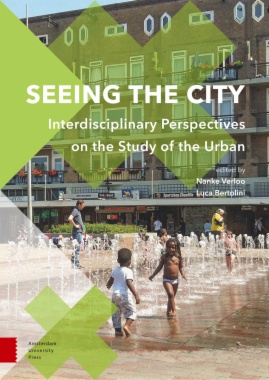The city is a complex object. Some researchers look at its shape, others at its people, animals, ecology, policy, infrastructures, buildings, history, art, or technical networks. Some researchers analyse processes of in- or exclusion, gentrification, or social mobility; others biological evolution, traffic flows, or spatial development. Many combine these topics or add still more topics beyond this list. Some projects cross the boundaries of research and practice and engage in action research, while others pursue knowledge for the sake of curiosity. This volume embraces this variety of perspectives and provides an essential collection of methodologies for studying the city from multiple, interdisciplinary, and transdisciplinary perspectives. We start by recognizing that the complexity of the urban environment cannot be understood from a single vantage point. We therefore offer multiple methodologies in order to gather and analyse data about the city, and provide ways to connect and integrate these approaches.
The contributors form a talented network of urban scholars and practitioners at the forefront of their fields. They offer hands-on methodological techniques and skills for data collection and analysis. Furthermore, they reveal honest and insightful reflections from behind the scenes. All methodologies are illustrated with examples drawn from the authors own research applying them in the city of Amsterdam. In this way, the volume also offers a rich collection of Amsterdam-based research and outcomes that may inform local urban practitioners and policy makers.
Altogether, the volume offers indispensable tools for and aims to educate a new generation of interdisciplinary and transdisciplinary-minded urban scholars and practitioners.
- Acknowledgments
- 1 �Introduction
- Nanke Verloo and Luca Bertolini
- Seeing the city
- Seeing Amsterdam
- Seeing this volume
- References
- 2 �Quantitative data collection: A meta view
- Introduction
- Origins of quantitative data collection and uses: the census
- Collecting survey data
- Administrative data
- Big data
- Conclusion
- References
- 3 �Urban ethnography and participant observations: Studying the city from within
- Why studying the city from within?
- ‘Thick description’, limitations, and underlying assumptions
- Preparing for ethnographic fieldwork
- Doing fieldwork
- Representing and interpreting ethnographic data
- Reflectivity and positionality
- Conclusions
- References
- 4 �Sensing the city through new forms of urban data
- Introduction
- Physical sensor data
- Mobile phone data
- Social media data
- User-generated & POI-based web data
- Summary
- References
- 5 �Interviewing in urban research
- Introduction
- The purpose of interviewing
- Developing the methodology: research sample
- Constructing an interview guide
- Ethical considerations and interview protocol
- Going into the field
- The art of interviewing
- Processing your data while in the field
- Conclusion
- References
- 6 �Digging in the crates: Archival research and historical primary sources
- Introduction
- What is an archive, and what lurks inside?
- Setting foot in murky waters
- Conclusion
- References
- 7 �Reading spaces: A cultural analysis approach
- Object selection, research questions, and analytical toolkit
- Analyzing aesthetics and discourse
- Reflection
- General conclusion
- References
- 8 �The practice of institutional analysis in urban contexts
- Objectives and motives of institutional analysis
- Distinguishing and connecting levels of analysis departing from institutional tensions
- Setting operational grids to set up the analysis
- Gathering and analyzing data in a targeted way
- The challenges of institutional analysis
- References
- 9 �Household preferences and hedonic pricing
- Hans R.A. Koster and Jan Rouwendal
- Introduction
- Micro-economic foundations
- Econometric estimation of hedonic price functions
- Summary
- References
- 10 �Urban research in another dimension: methods for modelling historical cities
- Introduction
- Mapping and modeling methods
- From dusty old archives to fuzzy new data
- Urban mapping and models
- Conclusion
- References
- 11 �Mapping the city: Geographic Information Systems and science in urban research
- Introduction: space matters
- Geographic Information Science and Systems
- Applying a GIS approach to research
- Conclusion
- References
- 12 �Methods for studying urban biodiversity
- Introduction
- Describing biodiversity
- General conclusions
- References
- 13 �Action research in the city: developing collaborative governance arrangements for the urban commons
- Joachim Meerkerk and Stan Majoor
- Introduction: Making the city together through action research
- 1 Performing action research: Becoming a contributive actor
- 2 Using a conceptual model to foster systemic transformation
- 3 Conclusions
- References
- 14 �Streetlabs as a co-creative approach to Research Through Design
- STBY (Nina Stegeman, Geke van Dijk, Bas Raijmakers)
- Introduction
- Streetlabs: a co-creative and collaborative approach
- Initial exploration and reframing
- Streetlab Facilitation
- Orchestrating conversations around current situation (AS IS) and future situation (TO BE)
- Documentation and analysis of the stories and ideas collected
- Delivering the results
- Implementation & Reflection
- Recommendations for further reading
- 15 �Too many cities in the city? Interdisciplinary and transdisciplinary city research methods and the challenge of integration
- Machiel Keestra and Nanke Verloo
- Introduction: Interdisciplinary, transdisciplinary and action research of a city in lockdown
- Setting the stage: establishing an ID/TD research team
- Integrating disciplinary perspectives
- Interdisciplinary research as an iterative process of mutual learning
- References
- 16 �Exploring city science
- Introduction
- The need for city science
- Current collaborations between cities and universities
- Research, Policy and Design
- City science, the research process
- Research design
- Discussion and future research
- References
- 17 �Conclusions
- Luca Bertolini and Nanke Verloo
- What did we see and understand?
- How did we progress?
- What did we miss?
- Agenda for Urban Research
- Glossary
- List of contributors
- Lege pagina

